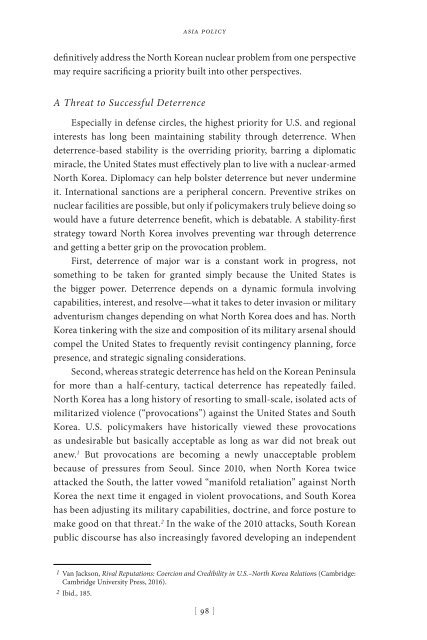2jBVKVf
2jBVKVf
2jBVKVf
You also want an ePaper? Increase the reach of your titles
YUMPU automatically turns print PDFs into web optimized ePapers that Google loves.
asia policy<br />
definitively address the North Korean nuclear problem from one perspective<br />
may require sacrificing a priority built into other perspectives.<br />
A Threat to Successful Deterrence<br />
Especially in defense circles, the highest priority for U.S. and regional<br />
interests has long been maintaining stability through deterrence. When<br />
deterrence-based stability is the overriding priority, barring a diplomatic<br />
miracle, the United States must effectively plan to live with a nuclear-armed<br />
North Korea. Diplomacy can help bolster deterrence but never undermine<br />
it. International sanctions are a peripheral concern. Preventive strikes on<br />
nuclear facilities are possible, but only if policymakers truly believe doing so<br />
would have a future deterrence benefit, which is debatable. A stability-first<br />
strategy toward North Korea involves preventing war through deterrence<br />
and getting a better grip on the provocation problem.<br />
First, deterrence of major war is a constant work in progress, not<br />
something to be taken for granted simply because the United States is<br />
the bigger power. Deterrence depends on a dynamic formula involving<br />
capabilities, interest, and resolve—what it takes to deter invasion or military<br />
adventurism changes depending on what North Korea does and has. North<br />
Korea tinkering with the size and composition of its military arsenal should<br />
compel the United States to frequently revisit contingency planning, force<br />
presence, and strategic signaling considerations.<br />
Second, whereas strategic deterrence has held on the Korean Peninsula<br />
for more than a half-century, tactical deterrence has repeatedly failed.<br />
North Korea has a long history of resorting to small-scale, isolated acts of<br />
militarized violence (“provocations”) against the United States and South<br />
Korea. U.S. policymakers have historically viewed these provocations<br />
as undesirable but basically acceptable as long as war did not break out<br />
anew. 1 But provocations are becoming a newly unacceptable problem<br />
because of pressures from Seoul. Since 2010, when North Korea twice<br />
attacked the South, the latter vowed “manifold retaliation” against North<br />
Korea the next time it engaged in violent provocations, and South Korea<br />
has been adjusting its military capabilities, doctrine, and force posture to<br />
make good on that threat. 2 In the wake of the 2010 attacks, South Korean<br />
public discourse has also increasingly favored developing an independent<br />
1 Van Jackson, Rival Reputations: Coercion and Credibility in U.S.–North Korea Relations (Cambridge:<br />
Cambridge University Press, 2016).<br />
2 Ibid., 185.<br />
[ 98 ]


